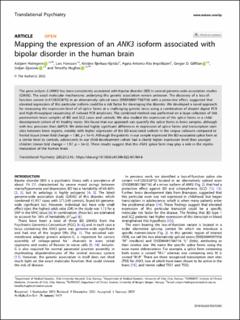| dc.contributor.author | Holmgren, Asbjørn | |
| dc.contributor.author | Hansson, Lars | |
| dc.contributor.author | Bjerkaas-Kjeldal, Kristine | |
| dc.contributor.author | Impellizzeri, Agata Antonia Rita | |
| dc.contributor.author | Gilfillan, Gregor | |
| dc.contributor.author | Djurovic, Srdjan | |
| dc.contributor.author | Hughes, Timothy | |
| dc.date.accessioned | 2022-10-05T10:33:27Z | |
| dc.date.available | 2022-10-05T10:33:27Z | |
| dc.date.created | 2022-05-12T15:27:46Z | |
| dc.date.issued | 2022 | |
| dc.identifier.issn | 2158-3188 | |
| dc.identifier.uri | https://hdl.handle.net/11250/3024001 | |
| dc.description.abstract | The gene ankyrin-3 (ANK3) has been consistently associated with bipolar disorder (BD) in several genome-wide association studies (GWAS). The exact molecular mechanisms underlying this genetic association remain unknown. The discovery of a loss-of-function variant (rs41283526*G) in an alternatively spliced exon (ENSE00001786716) with a protective effect, suggested that elevated expression of this particular isoform could be a risk factor for developing the disorder. We developed a novel approach for measuring the expression level of all splice forms at a challenging genetic locus using a combination of droplet digital PCR and high-throughput sequencing of indexed PCR amplicons. The combined method was performed on a large collection of 568 postmortem brain samples of BD and SCZ cases and controls. We also studied the expression of the splice forms in a child-development cohort of 41 healthy males. We found that our approach can quantify the splice forms in brain samples, although with less precision than ddPCR. We detected highly significant differences in expression of splice forms and transcription start sites between brain regions, notably with higher expression of the BD-associated isoform in the corpus callosum compared to frontal tissue (mean fold change = 1.80, p < 1e-4). Although the patients in our sample expressed the BD-associated splice form at a similar level to controls, adolescents in our child-development cohort had a clearly higher expression level than younger children (mean fold change = 1.97, p = 5e-3). These results suggest that this ANK3 splice form may play a role in the myelin maturation of the human brain. | en_US |
| dc.language.iso | eng | en_US |
| dc.publisher | Springer Nature | en_US |
| dc.rights | Navngivelse 4.0 Internasjonal | * |
| dc.rights.uri | http://creativecommons.org/licenses/by/4.0/deed.no | * |
| dc.title | Mapping the expression of an ANK3 isoform associated with bipolar disorder in the human brain | en_US |
| dc.type | Journal article | en_US |
| dc.type | Peer reviewed | en_US |
| dc.description.version | publishedVersion | en_US |
| dc.rights.holder | Copyright 2022 the authors | en_US |
| dc.source.articlenumber | 45 | en_US |
| cristin.ispublished | true | |
| cristin.fulltext | original | |
| cristin.qualitycode | 1 | |
| dc.identifier.doi | 10.1038/s41398-022-01784-6 | |
| dc.identifier.cristin | 2024037 | |
| dc.source.journal | Translational Psychiatry | en_US |
| dc.identifier.citation | Translational Psychiatry. 2022, 12, 45. | en_US |
| dc.source.volume | 12 | en_US |

